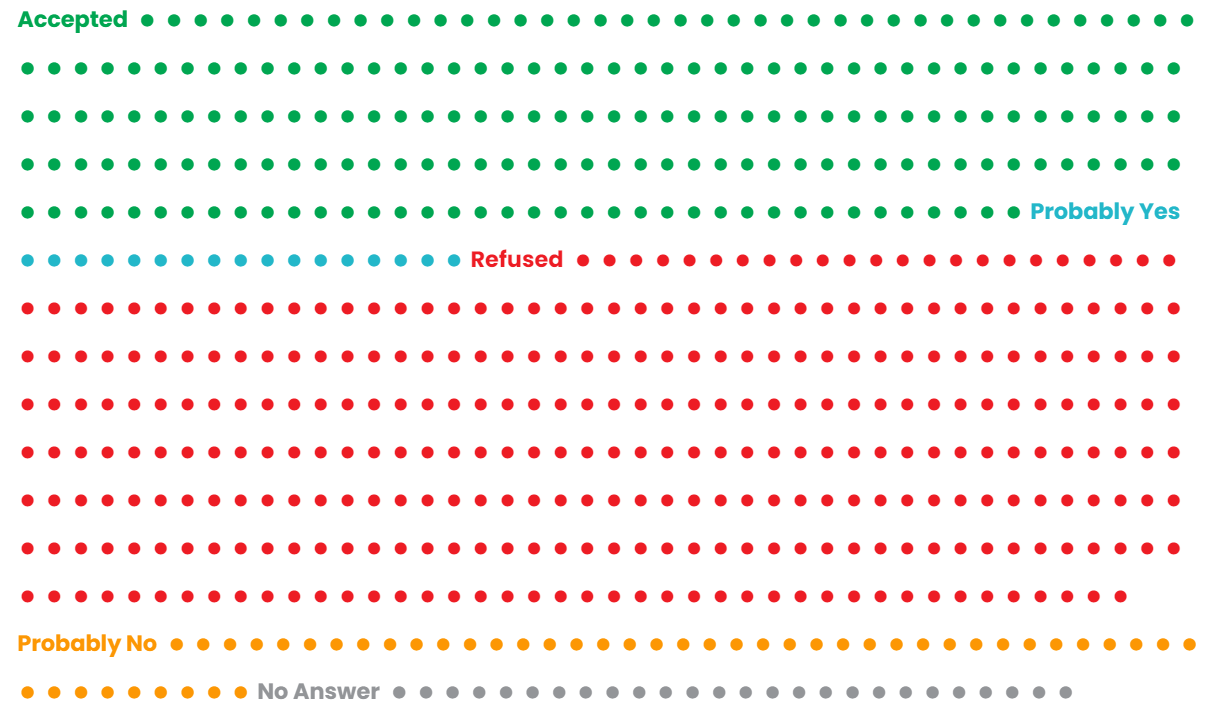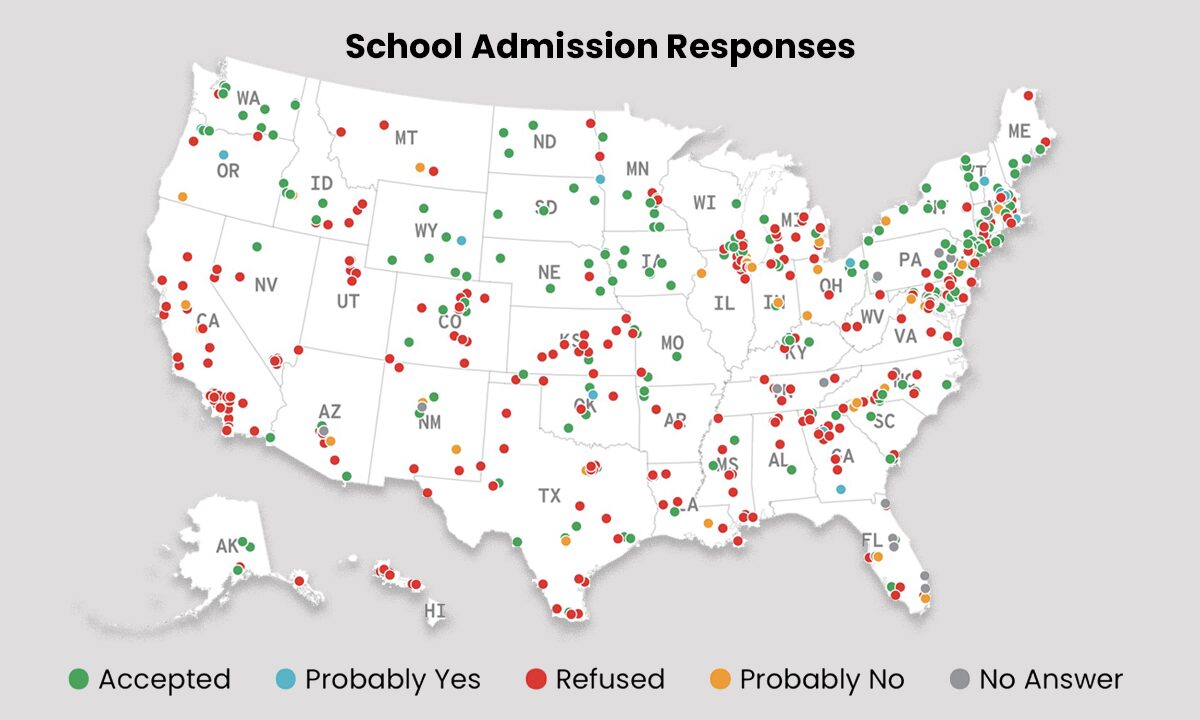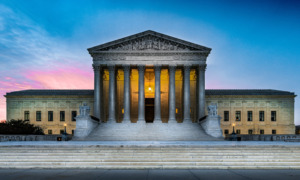This story first appeared at The 74, a nonprofit news site covering education.
![]()
In 35 states, students have a right to attend high school until at least age 20; a 74 investigation revealed a 19-year-old was repeatedly turned away.

“He is not going to achieve the end result: He is never going to finish high school in the time he has.” Registrar
“Does he speak good English?” School counselor
“We wouldn’t be able to have a 19-year-old with 14-year-olds.” Family engagement counselor
“At the end of the day, what is the person doing if they can’t get a diploma? ” Principal
“I don’t think we could deny, but him being much older than the other kids … he wouldn’t get to participate in extracurriculars.” Principal
“Our adult ed would be the place for him.” School counselor
![]()
Sometimes, it takes just a few seconds for a high school staffer to end a newcomer student’s educational career.
Other times, it can take slightly longer for a gentle push to morph into a shove as secretaries, registrars, counselors and principals say, with increasing irritation, that older immigrant students are destined to fail.
Bottom line, they insist, these new arrivals are not worth enrolling.
“He’s going to come to us and he’s going to be a dropout,” Paul Measso, director of school counseling at New Jersey’s Kearny High School, said when asked to admit a 19-year-old Venezuelan transplant as part of an undercover investigation by The 74.
It took Measso a mere three minutes to deny the teen, even though all students have a legal right to attend high school in New Jersey through age 20.
Whether a refusal comes in an instant or after a lengthy back-and-forth, the result is the same: a door critical to success in America is shuttered.
The 74’s 16-month-long investigation found such rejections rampant. The news outlet tested the enrollment practices of more than 600 high schools in all 50 states and Washington, D.C., attempting to register a 19-year-old who spoke little English and whose education had been interrupted.
More than 300 schools refused to register him
— including 204 denials in the 35 states and the District of Columbia where high school attendance goes up to at least age 20. State officials in almost all these locations separately confirmed to The 74 that a 19-year-old could not be turned away because of his age. A few did not respond.
“It saddens me to hear that in 2024, we are still denying kids a right to an education and a shot at a diploma,” said student immigration advocate and policy expert Timothy Boals.
“It’s pathetic that this continues to go on.”
The 74’s investigation also revealed:
- High school enrollment for these students is arbitrary and unpredictable: Schools in the same state, the same county and the same district gave contradictory answers. Different staffers within the very same building sometimes disagreed, proving it didn’t matter where our test student landed, but on who picked up the phone that day.
- There was no uniformity in who answered this high-stakes question and their responses were rife with bad information. Hundreds of employees, including temporary office staff, replied without hesitation, seemingly unaware or misinformed about their state’s regulations.
- Many staffers who agreed to enroll our newcomer did so begrudgingly. A third of the acceptances came at the tail-end of long, contentious calls — and only after school employees were asked whether their “firm recommendation” that the student go elsewhere meant he was refused. Only then did many acknowledge the law in their state and admit him.
- Several staffers said he could enroll, but that his participation would be severely limited: Some would allow him to take only ESL classes while others barred him from extracurricular activities. Such disparate treatment is illegal under federal civil rights laws.
- Many required birth certificates upfront even though federal guidelines say schools “may not prevent or discourage” students from attending without them. Others demanded transcripts before even considering enrollment. There was no consistency in how these rules were applied within states or districts.
- Some staffers tied the enrollment request to citizenship. They asked repeatedly about visas, insinuating that the new arrival was pursuing his education only to improve his immigration status. Federal civil rights laws require that school districts enroll all students regardless of their or their parents’ or guardians’ “actual or perceived citizenship or immigration status.”
- Of the hundreds of staffers who refused or discouraged our test student, many said he would age out before completing high school while others noted his peers had already graduated. Advocates and several state education officials said newcomers should not be singled out based on predictions about their future. Many students across the board fail to graduate but schools don’t prevent them from attending.
Overall, The 74’s investigation revealed pervasive hostility and suspicion toward these students in a particularly xenophobic era, as evidenced by the current presidential race. Donald Trump, the presumptive Republican nominee, said in December that immigrants are “poisoning the blood of our country” and more recently called undocumented people “animals.”
At the same time, conservative forces are strategizing to overturn Plyler v. Doe, the landmark 1982 Supreme Court ruling that a child cannot be denied a public education based on immigration status.
“I’m not surprised that [older immigrant students] are routinely rejected,” Adam Strom, founding director of Re-Imagining Migration, told The 74. “I’m surprised by how high the percentage is. That’s shocking.”
Hard ‘noes’ and harder ‘yeses’
Roughly 1.1 million people ages 18 to 20 entered the United States between 2012 and 2021, according to the Migration Policy Institute.
High school, advocates told The 74, is a place where they can build strong relationships with peers and teachers and learn to navigate life in a new country.

eon Rafael/Shutterstock
Mexican teen south of the Mexican border waits to be processed.
Enrollment means they’ll hear English all day long, which helps newcomers learn the language far faster than if they attended an alternative program for just a few hours each week. And they can progress in other subjects as well while forging inroads to college or better positioning themselves for employment.
Our test student was a stand-in for these older, new arrivals, whose rejection by the nation’s public schools goes unrecorded. To capture how schools react to such registration requests, The 74 senior reporter Jo Napolitano presented herself as a private citizen trying to enroll her 19-year-old nephew, “Hector Guerrero.” Using her own name, she told school officials Hector had arrived in the United States just weeks earlier and was eager to continue his education.
“To be explicit, it’s going to be a waste of time,” said Jim Karedes, principal of Delavan-Darien High School in Wisconsin, where students can legally stay in public school until age 20. “We could babysit him and that’s about what it would be. It would not behoove him to go down this pathway. He is 100% going to be a dropout.”
Pressed to say if this meant the school would not allow him in, Karedes admitted Hector.
Unwelcome to America
![]()
How we did the story: The 74 probes enrollment discrimination at 630 schools
Senior reporter Jo Napolitano called more than 600 schools in every state and D.C. attempting to register a 19-year-old new arrival from Venezuela.
After our initial contact seeking to enroll our test student, The 74 reached out multiple times to every staffer and school named in the story. Napolitano explained the circumstances surrounding their original conversation and gave them an opportunity to respond. Most did not; read the responses* of those who did comment here.
![]()
Of the 630 schools Napolitano contacted, 209 agreed to enroll him, 330 refused him, 17 said they would probably accept him and 48 indicated they likely would not. Twenty-six never responded despite numerous follow-up calls.
DATA ANALYSIS
Refusals Far Outnumbered Acceptances for 19-year-old Test Student

Napolitano advocated for the teen in a way that would be difficult — if not impossible — for immigrant students or their families. Many do not speak English and are unaware of their legal rights, leaving them ill-equipped to contest rejections or resist steering to alternative programs.
In order to count as a refusal, staffers had to outright deny Hector’s enrollment, rather than merely state — as many did, forcefully — that he belonged in a GED program, adult education or community college.
[Related: Older immigrant students say high school admission bettered their lives in U.S.]
After rejecting him, one high school staffer in Oklahoma, where the maximum enrollment age is 21, suggested Hector should instead “check with the public library or the Catholic Church.”
Red and blue state surprises
The 74’s investigation, which entailed thousands of phone calls between February 2023 and May 2024, revealed striking contrasts and unexpected outcomes in many places throughout the country.
Hector did not receive a single rejection in Iowa, a state whose staunchly Republican governor recently signed into law a Texas-style rule allowing police to arrest the undocumented. The law, which will take effect in July, makes it a crime to enter the state after a deportation. Yet seven of the nine high schools we queried accepted our newcomer — and two said they would likely enroll him.
He also fared well in deep-red Wyoming, Nebraska and South Dakota.
Likewise, four of five schools in Missouri accepted our student despite state Republicans’ effort to implement strict deportation orders and effectively bar undocumented students from college.
Results were quite different among California, Texas, Florida and New York, where more than half — 37.5 million — of the nation’s roughly 64 million Hispanic residents live. Hector was turned away far more often than he was admitted in those states: The 74 registered 65 refusals and 33 acceptances among them.
While those “noes” might be expected in often hard-right Texas and Florida, Hector was roundly rejected in progressive California, with 33 of 35 schools denying him and two others likely to refuse him.
California is home to more undocumented immigrants than any other state in the union, and has taken far-reaching measures to shield residents from deportation. Yet it provides no protection for general education students who wish to enroll in high school past the state’s compulsory attendance age of 18.
Schools in New York, where a former state attorney general sued the Utica City School District in 2015 for shunting refugees into inferior programs, broke with the pack: 23 accepted Hector while five denied him.
In Illinois, he was rejected at 25 high schools — out of 32 total — including seven in Chicago, a city that has publicly welcomed new arrivals.
Though they are both located in the Southwest and have roughly the same percentage of Hispanic residents, Nevada (30.3%) and Arizona (32.5%) diverged greatly in their responses.
Arizona, home to former Maricopa County sheriff Joe Arpaio, whose 24-year reign of terror against immigrants led to a criminal conviction and a controversial presidential pardon, was far more welcoming to Hector than its neighbor. This, despite the Grand Canyon State’s recent push to allow landowners to shoot and kill those who illegally cross the border from Mexico.
Only 1 in 16 Nevada high schools admitted our student but he was permitted to enroll at 6 of 18 Arizona schools — and would likely be accepted at one more.
When registration is random
Almost all 50 states and D.C. have laws establishing a maximum age for public school enrollment. But The 74’s investigation revealed they are often disregarded on the ground.
While Hector was turned away from 204 schools where he had a right to attend according to his age, he was accepted at 31 schools where state statute would have allowed staffers to refuse him for that same reason.
The 74 found that for newcomers, enrollment is haphazard. School personnel at every level seemed unaware of state regulations or misinformed about the specifics. In addition, in some states, the statutes are less than straightforward. Many local employees expressed confusion on the issue or said their district or county set its own rules.
State-By-State Enrollment Regulations By Age
| Alabama | “Every child between the ages of six and 17 years shall be required to attend a public school, private school, church school, or be instructed by a competent private tutor.” |
| Alaska | A student is considered school age until they are 20 |
| Arizona | Between the ages of 6 and 21 |
| Arkansas | Between the ages of 5 and 2 |
| California | There is no specific maximum age, but education code states, “Each person between the ages of 6 and 18 years … is subject to compulsory full-time education.” |
| Colorado | Younger than 21 |
| Connecticut | Under 21, but students 19 and older can be placed in “another suitable educational program” if they “cannot acquire a sufficient number of credits for graduation by age twenty-one.” |
| Delaware | Through age 20 |
| Florida | Local districts decide |
| Georgia | 21 |
| Hawaii | 20 |
| Idaho | Between the ages of 5 and 21, but schools can set a maximum age for enrollment |
| Illinois | Until age 21 |
| Indiana | No maximum age, but placement of adult students with limited interrupted formal education is a local decision. |
| Iowa | Between the ages of 5 and 21 |
| Kansas | No maximum age for high school enrollment. A district doesn’t have to take any student over the age of 21 but can if it chooses. |
| Kentucky | Under 21 |
| Louisiana | Local districts decide |
| Maine | An eligible student has not reached age 20 before the start of the school year |
| Maryland | “All individuals who are 5 years old or older and under 21 shall be admitted free of charge to the public schools of this State.” |
| Massachusetts | “Although no Massachusetts law or regulation sets the maximum age for enrollment, G.L. c. 71B, § 1 defines ‘school age child’ as ‘any person of ages three through twenty-one who has not attained a high school diploma or its equivalent.’” |
| Michigan | In general, “students will remain eligible for membership if they were less than 20 as of September 1 of the school year.” |
| Minnesota | Until 21 |
| Mississippi | “The state of Mississippi follows MS 1-3-27 and establishes the age of majority in our state as 21, or if they are otherwise emancipated. Therefore, read together, a student would be allowed to attend school through their age of majority, but is not forced to beyond age 17.” |
| Missouri | Up to age 21 |
| Montana | Locally decided |
| Nebraska | Between the ages of 5 and 21 |
| Nevada | Students may attend a comprehensive public school up until age 21, or may attend an “Adult High School program from 18 years to any age older.” |
| New Hampshire | Until 21 |
| New Jersey | Through 20 |
| New Mexico | Under 22 |
| New York | Under 21 |
| N. Carolina | Under 21 |
| N. Dakota | The child has not reached age 21 before Aug. 1 of the year of enrollment. |
| Ohio | Under 22 |
| Oklahoma | “All children between the ages of five (5) years on or before September 1, and twenty-one (21) years on or before Sept. 1, shall be entitled to attend school free of charge in the district in which they reside.” |
| Oregon | Local decision |
| Pennsylvania | 21 |
| Rhode Island | “There is no maximum school age under Rhode Island law. Thus, whether to enroll a student without any disability who is over eighteen (18) years of age is left to the discretion of the local school district.” |
| S. Carolina | Students ages 3–21 enrolling in South Carolina public schools must be allowed to do so at all grade levels. Adult Education is a viable option for some students 17 and over, but students must fully understand that they have the right to enroll in public high school if they choose to do so. |
| S. Dakota | 21 |
| Tennessee | There is no age limit for public schools in Tennessee. However, school districts are given latitude to determine student assignment or placement. |
| Texas | “A person who, on the first day of September of any school year, is at least five years of age and under 21 years of age, or is at least 21 years of age and under 26 years of age and is admitted by a school district to complete the requirements for a high school diploma is entitled to the benefits of the available school fund for that year. |
| Utah | “A student cannot enroll in a Utah public school if they are over age 18 or they have already earned a diploma.” |
| Vermont | “There is not a firm age limit on a student that can attend high school. Yes, a student can pursue their degree at any age, this is not specifically outlined in statute.” |
| Virginia | “‘Person of school age’ means a person who will have reached his fifth birthday on or before September 30 of the school year and who has not reached twenty years of age on or before August 1 of the school year.” |
| Washington | Less than 21 |
| W. Virginia | “The West Virginia Department of Education has typically given guidance to counties that they use age 21 as the age cut-off. State Board Policy 2800 defines ‘School-Aged Student’ as follows: Students between the ages of three and 21, provided students have not yet turned 21 years of age prior to Sept. 1.” |
| Wisconsin | Between ages 4 and 20 |
| Wyoming | Up to 21 |
| D.C. | There is no maximum age, but “migrant students have the right to pursue high school studies until the age of 21.” |
Source: State regulations and state education officials.
In some cases, they gave contradictory answers inside the same school
After checking with her boss, a staffer at Harry S. Truman High School in Levittown, Pennsylvania, accepted Hector in May 2023.
An administrative assistant in student services called back more than a week later to categorically deny him.
“I don’t even know if a school would accept him at age 19, but we only register up to 18,” Helene Hodoba said. “I’m not even sure who you can contact. But I do know for a fact they would have to be 18 to register, not 19.”
Pennsylvania regulations state that students can remain in high school until they graduate or reach the age of 21. A state department of education spokesman confirmed that a 19-year-old should be able to attend.




























